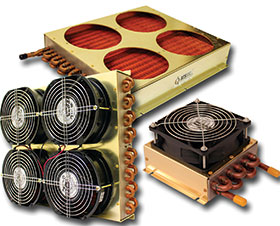Liquid-to-air heat exchangers
14 June 2017
Circuit & System Protection

Advanced Thermal Solutions has released a new line of tube-to-fin, liquid-to-air heat exchangers. Made with the highest density fins to maximise heat transfer from liquid to air, the products allow the liquid to be cooled to very low temperatures.
The heat exchanger fins and tubes are made of copper and stainless steel to be suitable for a variety of fluids, including water, dielectric fluids and custom designed heat transfer fluids. Each of the seven heat exchanger sizes is available with or without a fan. ATS offers 49 options of heat exchangers to meet a variety of needs. Lengths range from 14,7 to 55,6 cm, widths from 14,7 to 35,6 cm, and heights from 4,6 to 6,6 cm. Tube diameters are available at 0,95 and 1,27 cm.
The heat exchangers have silver-solder brazed joints and have been internally cleaned and externally coated for corrosion protection. ATS pressure tests them and can customise them for different fans. They have heat transfer capacities up to 250 W per 1°C difference between the inlet liquid and the inlet air temperatures.
These heat exchangers can be used in a number of applications, including automotive, aerospace, medical, laser cooling, electronics cooling, compressor cooling, semiconductor processing and HVAC.
For more information contact Advanced Thermal Solutions, [email protected], www.qats.com
Further reading:
Clearing the Static: Effectively control static in your workplace
Actum Electronics
Circuit & System Protection
Controlling electrostatic discharge in the workplace is crucial to protect sensitive electronic equipment from damage. Implementing an ESD control program involves various measures and tests.
Read more...
Clearing the Static: Staying grounded: Ensuring effective ESD control
Actum Electronics
Circuit & System Protection
To maintain reliable electrostatic discharge control, regular testing and accurate measurement are essential, with grounding products and ESD testing equipment being vital.
Read more...
Clearing the Static: ESD component safety in storage and transportation
Actum Electronics
Circuit & System Protection
Conductive containers create a Faraday cage effect, safely channelling electrostatic charges away from the components inside.
Read more...
Clearing the Static: Conductive foot, heel and shoe grounders
Actum Electronics
Circuit & System Protection
Conductive foot, heel and shoe grounders are used in electrostatic discharge protected areas to provide a path to ground for static electricity.
Read more...
LED driver for industrial power supply indication
Altron Arrow
Editor's Choice Circuit & System Protection
A simple and small solution for driving an LED to provide visual feedback in the presence/absence of a system’s power using a chip not originally designed for this purpose.
Read more...
Clearing the Static: Cleaning in an ESD-protected area
Actum Electronics
Circuit & System Protection
Cleaning in a protected electrostatic discharge area is a critical task to maintain the integrity of sensitive electronic components and prevent damage caused by static electricity.
Read more...
Clearing the Static: Key principles of ESD control in electronics manufacturing
Actum Electronics
Circuit & System Protection
Effectively managing electrostatic discharge is essential in electronics manufacturing to ensure not only product reliability, but also worker safety.
Read more...
Clearing the Static: Three steps for a dry ESD packaging system
Actum Electronics
Circuit & System Protection
For optimal storage, it’s essential to complete the dry-packaging system by adding Desiccant Packs and Humidity Indicator Cards.
Read more...
Ensuring safety with earth leakage protection
NewElec Pretoria
Circuit & System Protection
Earth leakage protection helps mitigate the risks of electric shocks, fires, and equipment damage by swiftly identifying faults and disconnecting the power supply, thus safeguarding both human lives and machinery.
Read more...
Suppressing EMI with filters
Vepac Electronics
Circuit & System Protection
EMI/RFI filters play an important role in reducing the high-frequency noise that is generated by various electrical and electronic devices.
Read more...


